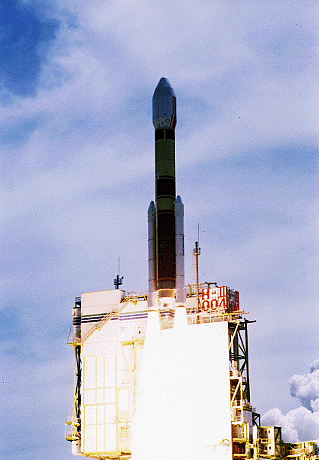- H-II
Infobox rocket
name =H-II
caption =The launch of H-II Flight 4, carryingADEOS
function =Launch vehicle
manufacturer =Mitsubishi Heavy Industries
country-origin =Japan
cpl-year =
cpl =
height =49 m
alt-height =160 ft
diameter =4 m
alt-diameter =13.1 ft
mass = 260,000 kg
alt-mass =570,000 lb
stages = 2
LEO-payload = 10,060 kg
alt-LEO = 22,170 lb
payload-location = GTO
payload = 3,930 kg
alt-payload = 8,660 lb
status = Retired
sites = LC-Y,Tanegashima
first=3 February 1994
last=15 November 1999
launches =7
success =4
fail =1
partial =2
boosters =2
boosterengines =1 Solid
boosterthrust =1,539.997 kN
alt-boosterthrust =
boosterSI =273 sec
boostertime =94 seconds
boosterfuel =Solid
stage1engines =1LE-7
stage1thrust =1,077.996 kN
alt-stage1thrust =242,343 lbf
stage1SI =446 sec
stage1time =346 seconds
stage1fuel =LOX /LH2
stage2engines =1LE-5A
stage2thrust =121.5 kN
alt-stage2thrust =27,313 lbf
stage2SI =452 sec
stage2time =600 seconds
stage2fuel =LOX /LH2 The H-II (H2) rocket was a
Japan ese satellite launch system, which flew seven times between 1994 and 1999, with five successes. It was developed byNASDA in order to give Japan a capability to launch largersatellite s of the 1990s.cite press release |title=H-II Launch Vehicle No.4 |publisher=NASDA |url=http://warp.ndl.go.jp/REPOSWP/000000001418/00000000000005995/www.nasda.go.jp/pr/services/presskit/h2-f4/h2index_e.html |language=English |accessdate=2007-06-25 ] It was the first rocket Japan made using only technologies developed domestically.cite web |author=JAXA |url=http://www.jaxa.jp/projects/rockets/h2/index_e.html |title=H-II Launch Vehicle |accessdate=2007-06-25 |work=Launch Vehicles and Space Transportation Systems |publisher=JAXA Website ] It was superseded by theH-IIA following reliability and cost issues.Background
Prior to H-II, NASDA had to use components licensed by the United States in its rockets. In particular, crucial technologies of the
H-I and its predecessors were from theDelta rocket s. The H-I did have domestically produced components, such as the LE-5 engine on the second stage and theinertial guidance system . H-II added to this by domestically developing the LE-7 liquid-fuel engine of the first stage and the solid booster rockets.The H-II was developed under the following policies, according to a NASDA press release:
#Develop the launch vehicle with Japanese space technology.
#Reduce both development period and costs by utilizing developed technologies as much as possible.
#Develop a vehicle which can be launched from the existingTanegashima Space Center .
#Use design criteria which allows sufficient performance for both the main systems and subsystems. Ensure that development will be carried out properly, and safety is taken into account.History
Development of the LE-7 engine which started in 1984 was not without hardships, and a worker died in an accidental explosion. The first engine was completed in 1994, two years behind the original schedule. In 1990,
Rocket System Corporation was established to operate the launch missions after the rockets' completion.In 1994, NASDA succeeded in launching the first H-II rocket, and succeeded in five launches by 1997. However, each launch cost 19 billion yen (190 million USD), too expensive compared to international competitors like Ariane. (This is in part due to the changes in exchange rates, which was 240 yen to a dollar when the project planning started in 1982, but had changed to 100 yen a dollar by 1994.) Development of the next-generation
H-IIA rockets started in order to minimize launch costs.The successive failure of flight 5 in 1998 and flight 8 in the following year brought an end to the H-II series. To investigate the cause of the failure and to direct resources into the H-IIA, NASDA cancelled flight 7 (which was to be launched after F8 due to changes in schedule), and terminated the H-II series.
H-II flights
Gallery
References
External links
* [http://www.jaxa.jp/projects/rockets/h2/index_e.html H-II Launch Vehicle] , JAXA.
Wikimedia Foundation. 2010.
